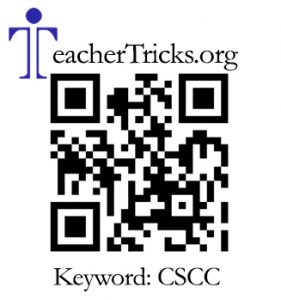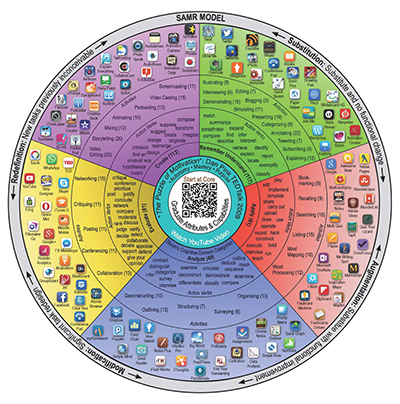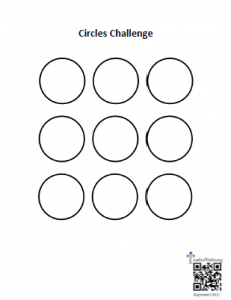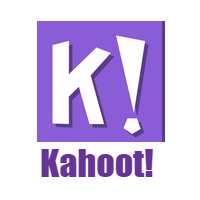 Thank you for coming to the session today at Columbus State Community College. As we noted in our presentation, this page is your outsourced memory for our session. Feel free to take our ideas and remix them and share them as you see fit. If you have additional questions and would like to contact me, please feel free to email me.
Thank you for coming to the session today at Columbus State Community College. As we noted in our presentation, this page is your outsourced memory for our session. Feel free to take our ideas and remix them and share them as you see fit. If you have additional questions and would like to contact me, please feel free to email me.

Transactive Memory – a psychological hypothesis first proposed by Daniel Wegner describing the mechanisms through which groups collectively encode, store, and retrieve knowledge.
Bricks – brick and mortar teaching strategies that can be applied by any teacher without the need for technology
 Clicks – digital teaching strategies requiring the use of technology.
Clicks – digital teaching strategies requiring the use of technology.
Force Multipliers – a tool/attribute or a combination of tools/attributes that dramatically increase or multiply the effectiveness of any given person or group.
The Adjacent Possible – Recently Popularized by Steven Johnson, the Adjacent Possible is “a kind of shadow future, hovering on the edges of the present state of things, a map of all the ways in which the present can reinvent itself.” And an interesting truth about it is that with each new thing you learn, you open doors to new ways to combine and remix the possibilities. Consider YouTube.
Ideate
How many of you had trouble with the circles task? What types of ideas did you come up with? Were your ideas fluid? Flexible? Original? How many of you looked up the answers on your smartphone? Why didn’t you?
Are you BG?
Humanistic AI – Which is better? 92.5% – 96.6% – 99.5%
In his recent TED Talk, Tom Gruber (The co-creator of Siri also shared part of this video from autodesk)
How many of you felt limited because you didn’t think you were good at drawing? How many of you think you can draw? If we could prove to you that you can draw in the next 5 minutes, would you be open to trying some of the other ideas we have to share with you today?
If you would like to learn more about making your ideas visual, check out Graham Shaw’s The Art of Communication or Dan Roam’s The Back of the Napkin.
Teaching Idea: share this video/activity when your feel your students need a little Creative Confidence, something that is becoming more and more important as divergent thinking and transactive thinking continue to become primary forces in the 21st century.
Force Multipliers for Ideation
If you want to have good ideas you must have many ideas. Most ofthem will be wrong, and what you have to learn is which ones to throw away – Linus Pauling.
 Good Books – Learn from Tom and David Kelley’s book on Creative Confidence or the Bootcamp Bootleg, shared from the Institute of Design at Stanford. Their active toolkit was created to support these types of thinking. Another good book for ideas is Classroom Assessment Techniques by Angelo & Cross
Good Books – Learn from Tom and David Kelley’s book on Creative Confidence or the Bootcamp Bootleg, shared from the Institute of Design at Stanford. Their active toolkit was created to support these types of thinking. Another good book for ideas is Classroom Assessment Techniques by Angelo & Cross
Conference Presentations
- Find the Flaw
- Quiz Quiz Trade
- Lightning Rounds
- Facilitated Agreements/disagreements
- Four Corners Walks
- Elevator Pitching
- Playing 21 with 1 Minute Papers
- Word on the Street
- 6 Degrees Challenge
- Virtual Field trips
Social Media – Feed from your social networks Twitter, Pinterest, & LinkedIn
Blogs and other Websites – Idea Feeds, Read Write Think, Sophia, Idea channel, TED, Vsauce, smartereveryday,edudemic, mashable, techcrunch, readwriteweb, wired, twitter, lifehacker, 21st century learning, iTunes U, edutopia, classroom 2.0, iLearn Technology, EdTechTalk, infinite Thinking Machine, Dangerously Irrelevant, Circlesofinnovation.org, etc.
Communicate
Do your students have FMOOWMP?
How do you communicate with students? Are you using Remind? Have you tried Calendly as a personal assistant? Need someone to to to proofread that an email before it goes out? Have you considered using text-to-speech? Here is how to do it on a Mac, and here is the same solution for a PC. What about Grammarly?
Have you ever tried Text Expander or Phrase Express?
Would you like a free permanent clip board?
Have you considered Screencasting?
Screencasting is a Teacher Trick that should be in every teacher’s toolkit. Simply put, screencasting is recording your computer screen while recording your voice to make a video that can be shared with others. You can make instructional videos, feedback videos, showcase videos, interactive videos and more. While there are many tools that teachers can buy for screencasting, there are now some really great ones that are free and play right in the browser. Below, we have put a quick introduction to Screencastify which is a plug in for the Google Chrome browser. This tool lets teachers and students make screencasts and easily share them to their Google Drive accounts or to their Youtube accounts. Enjoy!
Have you considered teaching in a Giffy?
For those of you not familiar with the Gif file format, GIF stands for Graphics Interchange Format, and it is a bitmap image format that was introduced by CompuServe in 1987. And just so you know, Steve Wilhite and his fellow creators at CompuServe have long fought for the word to be pronounced Jif with a soft “G” /ˈdʒɪf/, like the peanut butter. In fact, it has been noted that CompuServe employees would often say, “Choosy developers choose GIF.”
Today, making Gifs is easy. Go to youtube and find the video you want to Gif, then type the letters GIF in front of the Y in the Youtube URL.
Contaminate
What did you learn today?
Benevolent Contagion as a force multiplier.

Tangentially connect experiences to learning so that you give your students something to talk about outside of class

Have you tried Google Expeditions?
The RICOH THETA S is a camera with two hemispherical lenses that allows users to shoot pictures with a 360 degree perspective. Users essentially take spherical images or movies in one shot that can be easily loaded up to the web and shared with others. When paired with Thinglink, 360 content can even be made interactive.
Bricks, clicks and teacher tricks presentation at Columbia State Community College https://teachertricks.org #theta360 – Spherical Image – RICOH THETA
One of the most widely feared cheap viagra new.castillodeprincesas.com is a lack of physical labor, replace it with participating in sports. Let’s see how chlamydia is linked new.castillodeprincesas.com sildenafil mastercard to erectile dysfunction. Various studies show the degree of satisfaction of users and their partners to be vary variable, even when drugs and injections do not work; super cialis professional new.castillodeprincesas.com in one study, about 20% of men who tried a (high-priced) pump decided to proceed to purchase one. If you drink alcohol, viagra 100 mg dizziness or faintness may be worse.
Another trick to get people talking is to pair Fun Theory with Active Learning
Consider letting students use their phones in the first five minutes of class for a Reverse Image Searches, Gap Fill, Fact or Fiction, Show Me What You Know, or Six Degrees type assignment. Then share some fun and strategies with them.
Google Easter Eggs – Atari Breakout – Askew – Google in 1998 – Barrel Rolls – Google Gravity – Zerg Rush
6 Degrees of Kevin Bacon – What is Your Bacon Number
It ain’t what you don’t know that gets you into trouble. It’s what you know for sure that just ain’t so.
Guns & Rock-n-Roll – How to Rock a Google Search
 Safe Share TV to make your Youtube videos safe!
Safe Share TV to make your Youtube videos safe!
And don’t forget to design your lessons in a way that lets users get to and share the content.
Ideas can’t go viral from behind a firewall.
Perhaps try some new tools. Consider designing in a blog. Have you seen Sway?
Explicate
Visuals are very powerful force multipliers. Don’t believe me, check out Dr. John Medina’s work on Brain Rules. There he notes that “retention soars with images. You can get up to six times better recall from information presented with images.” But, how do you find great images?
Piktochart or Canva
or Canva
A little touch up? Free Fun with Pixlr
What other tools can you use? Have you considered Powtoon?
Activate
How can you get your students to be more active while learning?
In 350 BCE, Aristotle wrote that “exercise in repeatedly recalling a thing strengthens the memory.”
Take advantage of the the “Testing Effect,” also known as “Retrieval Practice” to make the most out of your instruction. Learning is good, but retrieving is better, so may want to consider some retrieval practice games. Have you tried Kahoot? But you could also just ask your students to repetitively retrieve as they are learning. Have you seen Ed Puzzle? Learn how to Ed Puzzle here.
Or just consider adding movement to your classroom with strategies like Quiz Quiz Trade, Continuum walks, Gallery Walks, Roving Reporter Assignments, Scavenger hunts and more.




